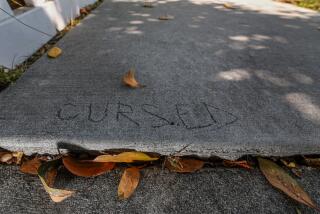Sloping Sidewalk Needs Shoring Up
- Share via
QUESTION: The concrete walk in the corner of our L-shaped house has settled to a slope of 3 or 4 inches. The slope causes rainwater to seep into the crawl space. Can we top this walk with a thin layer of concrete, or will it crumble?
ANSWER: You have three choices: Replace the slab, top it with a layer of concrete, or lift it up and fill in under it. There are two ways a homeowner can lift a slab. If the edge of the slab is accessible, you can use a pry bar. If the edge is not accessible, or it’s too big to pry up, you can jack it up.
Span across the slab with two 2-by-4s placed on edge. Bore holes through the 2-by-4s and through the concrete slab (rent a hammer drill if need be). Take some threaded rod (known as all thread) and put a spring-loaded wing on the end of each. Push the rod through each hole in the 2-by-4s and into the holes in the slab.
Put a washer and nut on top of each rod and thread the nut down. Drive the rod down, with a hammer if necessary, until the wings open under the slab. Be sure to put the nuts on the threaded rod before driving the rod down. Driving the rod will mushroom the threads and make it difficult to thread the nuts on the rod.
Tighten the nuts against the 2-by-4s to jack up the slab. Then pour a slurry of cement, sand and water through the open holes in the slab to fill the void underneath. Turn the rod out of the nuts when the filler under the slab has set up a little. Patch the holes, and the job is done.
Protect Stored Paint From Developing Skin
Q: What’s the best way to store partly used cans of paint without having them develop skin on the surface?
A: Here are several solutions that have worked for us.
* Store the can upside down.
* Cut a piece of wax paper the same diameter as the inside of the can and drop it down on top of the paint. When you are ready to paint again, simply remove the paper and the paint under it will be ready to stir and use without lumps or pieces of dried paint skin to strain out.
* Blow into the can before you put the lid on it. The carbon dioxide in your breath prevents the paint from oxidizing. Printers use this system to prevent skin from forming on unused inks.
* The best answer we’ve found is to pour a thin layer of the proper solvent for the type of paint onto the surface of the paint left in the can. Use just enough thinner to cover the surface of the paint. Then, the next time you use the paint, simply stir the thinner into the paint. This way, you have no skin formed at all and there is nothing in the can to fish out and dispose of. Besides, most paints will spread much more easily when they are slightly thinned, especially those that thickened a little as their solvents evaporated during storage.
Tub Water Faucet Leaks When Shower Is On
Q: The water pressure in our tub is good. However, when we turn on the shower, some water continues to come out of the tub faucet, and the water pressure from the shower is reduced. How can we correct this problem?
A: The problem is with the tub-shower diverter valve. When the valve is functioning properly, all the water should be channeled to the tub or shower.
There are two common types of diverters. In the tub spout diverter, a small gate valve is attached to the base of a plunger shaft located in the spout. It is held in the up position for the shower by water pressure. When the water is turned off, the gate drops and opens the tub spout. To remove it for repair, unscrew the tub spout from the threaded water pipe.
The other diverter works by rotating the valve stem so the parts in the valve body open to either the tub spout or the shower pipe. You can remove the mechanism by unscrewing the stem nut and withdrawing the diverter assembly.
Tub diverter spouts and diverter assemblies cost $10 to $15 at plumbing supply stores. Since there are different types and sizes of tub-shower diverters available, take the old one with you to make sure you get an equivalent replacement.
*
To submit a question, write to Popular Mechanics, Reader Service Bureau, 224 W. 57th St., New York, NY 10019. The most interesting questions will be answered in future columns.

